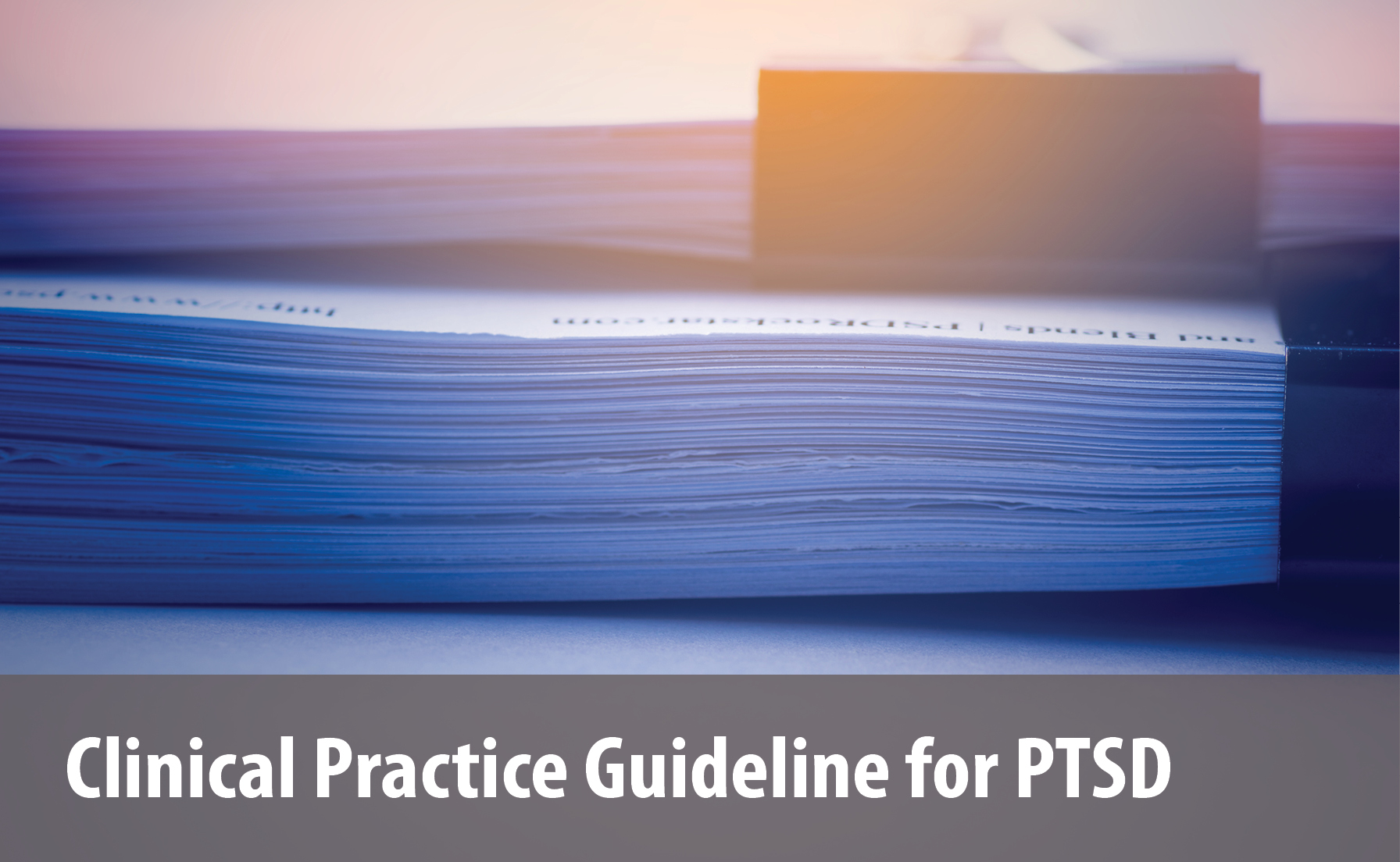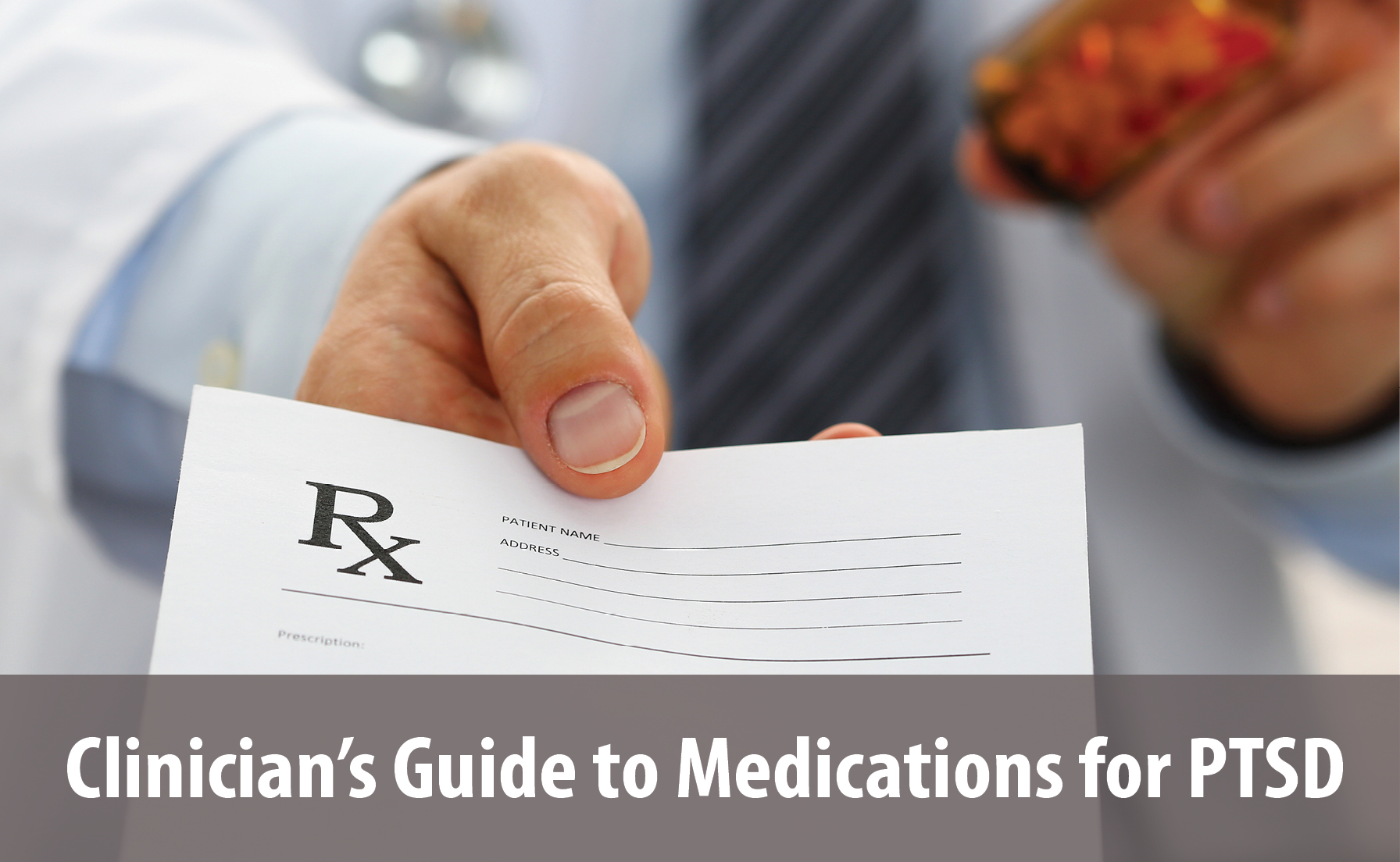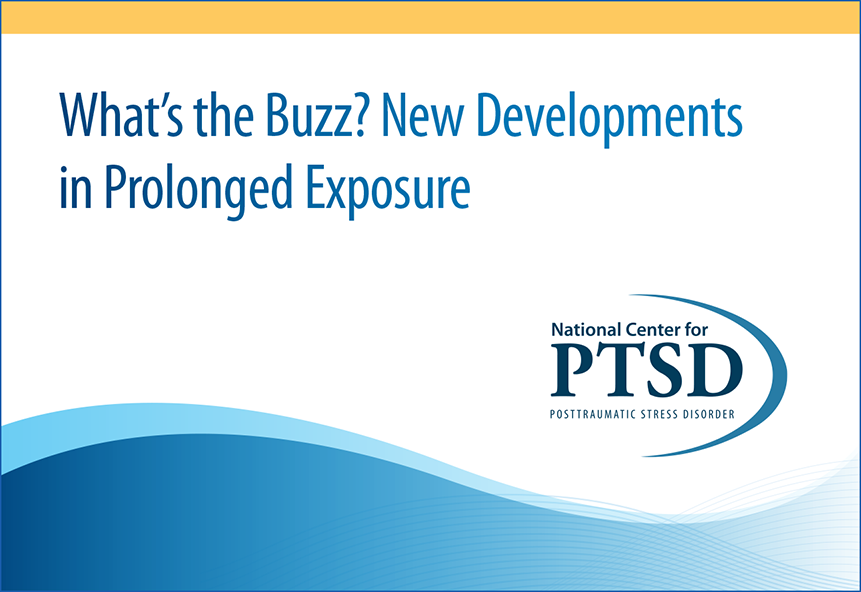Prolonged Exposure for PTSD
Prolonged Exposure for PTSD
Prolonged Exposure (PE) is one of the most studied treatments for PTSD. Based on the large number of studies showing it is effective for use across diverse patient presentations, PE has the strongest recommendation as a treatment for PTSD in every clinical practice guideline. PE is a trauma-focused psychotherapy that works to treat PTSD in patients with complicated presentations, including those with comorbidities such as substance use disorder.
Continuing Education Course
What's the Buzz? New Developments in Prolonged Exposure for PTSD
This online course reviews the evidence base for the effectiveness and efficacy of Prolonged Exposure for PTSD.
In This Article
Theoretical Model
PE, developed from Emotional Processing Theory (1), proposes that pathological fear and other emotional structures develop after trauma in those who go on to have PTSD and that these pathological fear/emotion structures need to be modified for recovery to occur. Fear/emotion structures are made up of a stimulus (people, places, things, memories), followed by an emotional and/or physiological response and thoughts regarding the meaning of the stimulus and response.
Fear/emotion structures become pathological when someone who has experienced a trauma (e.g., a gas explosion) experiences a stimulus that most people would consider safe (e.g., filling up a tank at a gas station or memory/images of gas explosion), responds with a considerable distress (e.g., heart pounding, desire to flee and avoid the situation), and attributes extremely negative meaning about the self, others, or world (e.g., "This situation is extremely dangerous," "I can't handle this.").
PE works to modify the fear/emotion structure through exposure and habituation to the feared (or avoided due to another negative emotional reaction) but relatively safe stimulus (e.g., staying at a gas station or thinking about the memory until the distress response diminishes). Exposure to the stimulus activates the structure and allows the client to learn that:
- Memories and reminders of the trauma are not dangerous and can be experienced without significant distress.
- Distress does not last forever.
- Emotional responses gradually reduce with time even without doing anything.
- Responses (such as heart racing) are not dangerous.
- The client can handle negative affect.
Recovery from PTSD occurs as the fear/emotion structure is modified such that stimuli no longer elicit extreme negative responses or meanings.
Session Content
PE is a manualized exposure-based psychological intervention designed to treat PTSD following trauma. PE is typically delivered in 8 to 15, 90-minute sessions, usually on a weekly basis. PE promotes emotional processing of the trauma memory through a deliberate systematic approach with trauma-related stimuli (2). The key components of PE are:
- Psychoeducation about common reactions to trauma, what maintains trauma-related symptoms, and how PE reduces PTSD symptoms
- Repeated in-vivo confrontation with situations, people or objects that the patient is avoiding because they are trauma-related and cause emotional distress, such as anxiety, shame or guilt.
- Repeated, imaginal exposure to the trauma memories (i.e., revisiting and recounting the trauma memory in imagery) followed by processing the details of the event, the emotions and the thoughts that the patient experienced during the trauma.
Overall and Relative Effectiveness
PE is one of the most researched interventions for PTSD. It has been studied in 65 randomized clinical trials (RCTs) where one or more of the treatment arms included PE, with more in progress (3). Meta-analyses (e.g., 4-10) suggest that PE produces large treatment effects in regard to PTSD symptom reduction and loss of diagnosis (e.g.,7).
The first RCT on PE was conducted by Foa and colleagues (1991) and examined the efficacy of PE compared to Stress Inoculation Training (SIT), supportive counseling (SC), and waitlist control (WL) among female survivors of sexual assault (11). Decreased PTSD symptoms were present for all groups posttreatment. At 3-month follow-up, the greatest reduction in PTSD symptoms was noted in the PE group. Resick and colleagues (2002) and Rothbaum, Astin, & Marsteller (2005) have also found PE to be superior to waitlist and equivalent to other trauma focused treatments in samples of female survivors of sexual assault (12,13). Based on intent to treat analyses, on average, 53% of those who initiate PE no longer meet diagnostic criteria for the disorder, and the rate of diagnostic change increases to 68% among individuals who complete treatment (14). Similarly, long-term follow-up data supports the efficacy of PE with 83% of patients who received PE no longer meeting diagnostic criteria 6 years following initial treatment (15).
A review by the Agency for Healthcare Research and Quality (16), which used extensive criteria for evaluating study quality, included 19 RCTs of PE. The review concluded that there is high strength of evidence to support the efficacy of exposure therapy such as PE for reduction of PTSD symptoms and depression symptoms, and loss of PTSD diagnosis and that trauma focused therapies such as PE are the most effective treatments for PTSD.
PE in Clinical Practice Guidelines
PE is recommended as a first-line treatment in all major PTSD treatment guidelines including the American Psychological Association (APA; 17), the International Society for Traumatic Stress Studies (ISTSS; 18), the United Kingdom's National Institute for Health and Care Excellence (NICE; 19), the U.S. Department of Veterans Affairs and Department of Defense (VA/DoD; 20) and the Australian Guidelines (21).
Research Across Diverse Populations
The intersectionality of race/ethnicity, gender, sexual orientation and class are important considerations in any mental health practice, including PE. Individuals who experience race-based traumas and bias-motivated violence (i.e., hate crimes) often experience posttraumatic symptoms such as shame, self-blame and greater levels of negative psychosocial symptoms, including PTSD (22,23). The individualized nature of PE treatment allows culturally competent providers to integrate these issues in the standard PE format. For example, excellent resources are available for possible adaptations of PE among Black patients, including assessment of and attention to race-based trauma as the origin of PTSD (24). Also see our Provider Guide to Addressing Patient Reactions to Race-Based Violence During PTSD Treatment article.
A recent review of clinical trials in PE found that Black patients have been well represented in PE clinical trials though other groups of color are underrepresented (25). Of note, McClendon et al. (2020) concluded in their review of the impact of race/ethnicity on PTSD treatment that race/ethnicity do not appear to impact magnitude of change but may impact initiation and retention (26). Thus, providers should be especially aware of access and retention issues when working with patients of color.
Research With Military Personnel and Veterans
Schnurr and colleagues (2007) conducted the first RCT in female Veterans and demonstrated PE to be more efficacious than Present-Centered Therapy (27). At follow-up, individuals who completed PE demonstrated a greater reduction of PTSD symptoms and were 1.8 times more likely to no longer meet diagnostic criteria for PTSD. A head-to-head RCT in post-9/11 Veterans compared sertraline plus enhanced medication management, PE plus placebo, and PE plus sertraline (28). Results revealed significant reductions in PTSD symptom severity in both PE plus placebo and PE plus sertraline. In an RCT of 916 veterans randomized to PE or another trauma focused treatment, Cognitive Processing Therapy (CPT), PTSD symptoms improved in both treatments. PE was more effective than CPT for reducing PTSD symptoms, but the difference between treatments did not reach clinical significance (29). Additional RCTs demonstrated effectiveness for reducing PTSD symptoms in U.S. military personnel (30), U.S. Veterans (e.g., 28,31,32), and Israeli Veterans (33).
Research With Comorbidities and Special Populations
PE is effective for reducing PTSD symptoms when comorbidities are present. As indicated in a meta-analytic review by Powers and colleagues (2010), PE is effective at reducing depression symptoms (34). For example, female survivors of sexual assault with a primary diagnosis of PTSD and comorbid depression experienced decreases in depressive symptomatology during the course of PE (12). Research examining PTSD and substance use disorder shows that PE integrated with or offered concurrently with substance use treatment is more effective for reducing PTSD symptoms, and in some studies substance use, than substance use only treatment (35-39). For example, one study found Concurrent Treatment for PTSD and Substance Use Disorder Using Prolonged Exposure (COPE) to be more effective in reducing PTSD symptoms than a non-trauma-focused treatment for PTSD and substance use disorder (40). Additionally, PE has been effective in ameliorating trauma-related guilt (12,41), other non-fear emotions such as anger and shame (41) and improves regulation of emotion (42,43).
Emerging Issues
Since a large body of research has established that PE is effective for treating PTSD, newer studies are targeting ways to make PE more accessible and even more effective. For example, several studies are examining alternative models of care that provide the key elements of PE in massed or brief protocols (30,44-46). Result from an RCT demonstrated that massed PE (10 sessions over a 2-week period) is not only well tolerated but yield low dropout rates (30). A shorter PE protocol for primary care also shows promising results (47). An RCT demonstrated that Prolonged Exposure for Primary Care which included 4, 30-minute appointments delivered over 4 to 6 weeks produced a large reduction in PTSD severity compared to a minimal contact control group (44). Such endeavors promise to increase patient access to effective intervention and retention in care. See McLean and Foa (2024) for an additional comprehensive review of PE for PTSD (48).
References
- Foa, E. B., & Kozak, M. J. (1986). Emotional processing of fear: Exposure to corrective information. Bulletin, 99(1), 20-35. https://doi.org/10.1037/0033-2909.99.1.20
- Foa, E. B. (2011). Prolonged exposure therapy: Past, present, and future. Depression and Anxiety, 28(12), 1043-1047. https://doi.org10.1002/da.20907
- National Center for PTSD. (2023). PTSD Trials Standard Data Repository (PTSD-Repository) [Data set]. https://ptsd-va.data.socrata.com
- Bisson, J. I., Roberts, N. P., Andrew, M., Cooper, R., & Lewis, C. (2013). Psychological therapies for chronic post-traumatic stress disorder (PTSD) in adults. Cochrane Database of Systematic Reviews, 12, Art. No.:CD003388. https://doi.org/10.1002/14651858.CD003388.pub4
- Cusack, K., Jonas, D. E., Forneris, C. A., Wines, C., Sonis, J., Middleton, J. C., Feltner, C., Brownley, K. A., Olmsted, K. R., Greenblatt, A., Weil, A., & Gaynes, B. N. (2016). Psychological treatments for adults with posttraumatic stress disorder: A systematic review and meta-analysis. Clinical Psychology Review, 43, 128-141. https://doi.org/10.1016/j.cpr.2015.10.003
- Jonas, D. E., Cusack, K., Forneris, C. A., Wilkins, T. M., Sonis, J., Middleton, J. C., Feltner, C., Meredith, D., Cavanaugh, J., Brownley, K. A., Olmsted, K. R., Greenblatt, A., Weil, A., & Gaynes, B. N. (2013, May). Psychological and pharmacological treatments for adults with posttraumatic stress disorder (PTSD). Comparative Effectiveness Review, No. 92. (Prepared by the RTI International-University of North Carolina Evidence-based Practice Center under Contract No. 290-2007-10056-I.) AHRQ Publication No. 12-EHC011-EF. Rockville, MD: Agency for Healthcare Research and Quality; April 2013. Retrieved from: www.effectivehealthcare.ahrq.gov/reports/final.cfm
- Watts, B. V., Schnurr, P. P., Mayo, L., Young-Xu, Y., Weeks, W. B., & Friedman, M. J. (2013). Meta-analysis of the efficacy of treatments for posttraumatic stress disorder. The Journal of Clinical Psychiatry, 74(6), e541-e550. https://doi.org/10.2088/jcp.12r08225
- McLean, C. P., Levy, H. C., Miller, M. L., & Tolin, D. F. (2022). Exposure therapy for PTSD in military populations: A systematic review and meta-analysis of randomized clinical trials. Journal of Anxiety Disorders, 90, 102607. https://doi.org/10.1016/j.janxdis.2022.102607
- McLean, C. P., Levy, H. C., Miller, M. L., & Tolin, D. F. (2022). Exposure therapy for PTSD: A meta-analysis. Clinical Psychology Review, 91, 102115. https://doi.org/10.1016/j.cpr.2021.102115
- Jericho, B., Luo, A., & Berle, D. (2022). Trauma-focused psychotherapies for post-traumatic stress disorder: A systematic review and network meta-analysis. Acta Psychiatrica Scandinavica, 145(2), 132-155. https://doi.org/10.1111/acps.13366
- Foa, E. B., Rothbaum, B. O., Riggs, D. S., & Murdock, T. B. (1991). Treatment of posttraumatic stress disorder in rape victims: A comparison between cognitive-behavioral procedures and counseling. Journal of Consulting and Clinical Psychology, 59(5), 715-723. https://doi.org/10.1037//0022-006x.59.5.715
- Resick, P. A., Nishith, P., Weaver, T. L., Astin, M. C., & Feuer, C. A. (2002). A comparison of cognitive-processing therapy with prolonged exposure and a waiting condition for the treatment of chronic posttraumatic stress disorder in female rape victims. Journal of Consulting and Clinical Psychology, 70(4), 867-879. https://doi.org/10.1037//0022-006x.70.4.867
- Rothbaum, B. O., Astin, M. C., & Marsteller, F. (2005). Prolonged exposure versus eye movement desensitization and reprocessing (EMDR) for PTSD rape victims. Journal of Traumatic Stress, 18(6), 607-616. https://doi.org/10.1002/jts.20069
- Bradley, R., Greene, J., Russ, E., Dutra, L., & Westen, D. (2005). A multidimensional meta-analysis of psychotherapy for PTSD. American Journal of Psychiatry, 162(2), 214-227. https://doi.org/10.1176/appi.ajp.162.2.214
- Resick, P. A., Williams, L. F., Suvak, M. K., Monson, C. M., & Gradus, J. L. (2012). Long-term outcomes of cognitive-behavioral treatments for posttraumatic stress disorder among female rape survivors. Journal of Consulting and Clinical Psychology, 80(2), 201-210. https://doi.org/10.1037/a0026602
- Forman-Hoffman, V., Middleton, J. C., Feltner, C., Gaynes B. N., Weber, R.P., Bann, C., Viswanathan, M., Lohr, K. N., Phil, M., Baker, C., & Green, J. (2018, May) Psychological and pharmacological treatments for adults with posttraumatic stress disorder: A systematic review update. Comparative Effectiveness Review, No. 207. (Prepared by the RTI International-University of North Carolina at Chapel Hill Evidence-based Practice Center under Contract No. 290-2015-00011-I for AHRQ and PCORI.) AHRQ Publication No. 18-EHC011-EF. PCORI Publication No. 2018-SR-01. Rockville, MD: Agency for Healthcare Research and Quality; May 2018. Retrieved from: www.effectivehealthcare.ahrq.gov/reports/final.cfm doi:10.23970/AHRQEPCCER207
- American Psychological Association (APA). (2017). Clinical practice guideline for the treatment of posttraumatic stress disorder (PTSD) in adults. Author. Retrieved from: https://www.apa.org/ptsd-guideline
- International Society for Traumatic Stress Studies (ISTSS). (2018). ISTSS PTSD prevention and treatment guidelines: Methodology and recommendations. Author. Retrieved from: http://www.istss.org/getattachment/Treating Trauma/New-ISTSS-Prevention-and-Treatment-Guidelines/ISTSS_ PreventionTreatmentGuidelines_FNL-March-19-2019.pdf.aspx
- National Institute for Health Care Excellence (NICE). (2018). Guideline for post-traumatic stress disorder. National Institute for Health and Clinical Practice. Retrieved from: https://www.nice.org.uk/guidance/ng116/chapter/Recommendations
- Departments of Veterans Affairs and Defense (VA/DoD). (2023). VA/DoD clinical practice guideline for the management of posttraumatic stress disorder and acute stress disorder. Author. Retrieved from: https://www.healthquality.va.gov/guidelines/MH/ptsd/
- Phoenix Australia Centre for Posttraumatic Mental Health. (2021). Australian guidelines for the prevention and treatment of acute stress disorder, posttraumatic stress disorder and Complex PTSD. Australian Government, National Health and Medical Research Council. Retrieved from: https://www.phoenixaustralia.org/australian-guidelines-for-ptsd/
- Bryant-Davis, T., & Ocampo, C. (2005). Racist incident-based trauma. The Counseling Psychologist, 33(4), 479-500. https://doi.org/10.1177/0011000005276465
- Carter, R. T. (2007). Racism and psychological and emotional injury. The Counseling Psychologist, 35(1), 13-105. https://doi.org/10.1177/0011000006292033
- Williams, M. T., Malcoun, E., Sawyer, B. A., Davis, D. M., Nouri, L. B., & Bruce, S. L. (2014). Cultural adaptations of prolonged exposure therapy for treatment and prevention of posttraumatic stress disorder in African Americans. Behavioral Sciences, 4(2), 102-124. https://doi.org/10.3390/bs4020102
- Benuto, L. T., Bennett, N. M., & Casas, J. B. (2020) Minority participation in randomized controlled trials for prolonged exposure therapy: A systematic review of the literature. Journal of Traumatic Stress, 33(4), 420-431. https://doi.org/10,1002/jts,22539
- McClendon, J., Dean, K. E., & Galovski, T. (2020). Addressing diversity in PTSD treatment: Disparities in treatment engagement and outcome among patients of color. Current Treatment Options in Psychiatry, ISSN: 2196-3061. https:/doi.org/10.1007/s40501-020-00212-0
- Schnurr, P. P., Friedman, M. J., Engel, C. C., Foa, E. B., Shea, M. T., Chow, B. K., Resick, P. A., Thurston, V., Orsillo, S. M., Haug, R., Turner, C., & Bernardy, N. (2007). Cognitive behavioral therapy for posttraumatic stress disorder in women: A randomized controlled trial. JAMA, 297(8), 820-830. https://doi.org/10.1001/jama.297.8.820
- Rauch, S. A., Kim, H. M., Powell, C., Tuerk, P. W., Simon, N. M., Acierno, R., Allar, C. B., Norman, S. B., Venners, M. R., Rothbaum, B. O., Stein, M. B., Porter, K., Martis, B., King, A. P., Liberson, Is., Phan, K. L., & Hoge, C. W.. (2019). Efficacy of prolonged exposure therapy, sertraline hydrochloride, and their combination among combat Veterans with posttraumatic stress disorder: A randomized clinical trial. JAMA Psychiatry, 76(2), 117-126. https://doi.org/10.1001/jamapsychiatry.2018.3412
- Schnurr, P. P., Chard, K. M., Ruzek, J. I., Chow, B. K., Resick, P. A., Foa, E. B., Marx, B. P., Friedman, M. J., Bovin, M. J., Caudle, K. L., Castillo, D., Curry, K. T., Hollifield, M., Huang, G. D., Chee, C. L., Astin, M. C., Dickstein, B., Renner, K., Clancy, C. P., Collie, C., Maieritsch, K., Bailey, S., Thompson, K., Messina, M., Franklin, L., Lindley, S., Kattar, K., Leudtke, B., Romesser, J., McQuaid, J., Sylvers, P., Varkovitzky, R., Davis, L., MacVicar, D., & Shih, M. C. (2022). Comparison of Prolonged Exposure vs Cognitive Processing Therapy for treatment of posttraumatic stress disorder among US Veterans. JAMA Network Open, 5(1), e2136921. https://doi.org/jamanetworkopen.2021.36921
- Foa, E. B., McLean, C. P., Zang, Y., Rosenfield, D., Yadin, E., Yarvis, J. S., Mintz, J., Young-McCaughan, S., Borah, E. V., Dondanville, K. A., Fina, B. A., Hall-Clark, B. N., Lichner, T., Litz, B. T., Roache, J., Wright, E. C., & Peterson, A. L., for the STRONG STAR Consortium. (2018). Effect of prolonged exposure therapy delivered over 2 weeks vs 8 weeks vs present-centered therapy on PTSD symptom severity in military personnel: A randomized clinical trial. JAMA, 319(4), 354-364. https://doi.org/10.1001/jama.2017.21242
- Ford, J. D., Grasso, D. J., Greene, C. A., Slivinsky, M., & DeViva, J. C. (2018). Randomized clinical trial pilot study of prolonged exposure versus present centered affect regulation therapy for PTSD and anger problems with male military combat Veterans. Clinical Psychology & Psychotherapy, 25(5), 641-649. https://doi.org/10.1002/cpp.2194
- Rauch, S. A., King, A. P., Abelson, J., Tuerk, P. W., Smith, E., Rothbaum, B. O., Clifton, E., Defever, A., & Liberzon, I. (2015). Biological and symptom changes in posttraumatic stress disorder treatment: A randomized clinical trial. Depression and Anxiety, 32(3), 204-212. https://doi.org/10.1002/da.22331
- Nacasch, N., Foa, E. B., Huppert, J. D., Tzur, D., Fostick, L., Dinstein, Y., Polliack, M., & Zohar, J. (2011). Prolonged exposure therapy for combat-and terror-related posttraumatic stress disorder: A randomized control comparison with treatment as usual. Journal of Clinical Psychiatry, 72(9), 1174-1180. https://doi.org/10.4088/jcp.09m05682blu
- Powers, M. B., Halpern, J. M., Ferenschak, M. P., Gillihan, S. J., & Foa, E. B. (2010). A meta-analytic review of prolonged exposure for posttraumatic stress disorder. Clinical Psychology Review, 30(6), 635-641. https://doi.org/10.1016/j.cpr.2010.04.007
- Back, S. E., Foa, E. B., Killeen, T. K., Teesson, M., Mills, K. L., Cotton, B. D., & Carroll, K. M. (2014). Concurrent treatment of PTSD and substance use disorders using prolonged exposure (COPE): Therapist guide. Oxford University Press, USA.
- Roberts, N. P., Roberts, P. A., Jones, N., & Bisson, J. I. (2015). Psychological interventions for post-traumatic stress disorder and comorbid substance use disorder: A systematic review and meta-analysis. Clinical Psychology Review, 38, 25-38. https://doi.org/10.1016/j.cpr.2015.02.007
- Ruglass, L. M., Shevorykin, A., Radoncic, V., Smith, K. M., Smith, P. H., Galatzer-Levy, I. R., Papini, S., & Hien, D. A. (2017). Impact of cannabis use on treatment outcomes among adults receiving cognitive-behavioral treatment for PTSD and substance use disorders. Journal of Clinical Medicine, 6(2), 14. https://doi.org/10.3390/jcm6020014
- Roberts, N. P., Lotzin, A., & Schäfer, I. (2022). A systematic review and meta-analysis of psychological interentions for comorbid post-traumatic stress disorder and substance use disorder. European Journal of Psychotraumatology, 13(1), 2041831. https://doi.org/10.1080/20008198.2022.2041831
- Hien, D. A., Morgan-López, A. A., Saavedra, L. M., Ruglass, L. M., Ye, A., López-Castro, T., Fitzpatrick, S., Killeen, T. K., Norman, S. B., Ehrahimi, C. T., & Back, S. E. (2023). American Journal of Psychiatry, 180(2), 155-166. https://doi.org/10.1176/appi.ajp.22010071
- Norman, S. B., Trim, R., Haller, M., Davis, B. C., Myers, U. S., Colvonen, P. J., Blanes, E., Lyons, R., Siegel, E. Y., Angkaw, A. C., Norman, G. J., & Myes, T. (2019). Efficacy of integrated exposure therapy vs intefrated coping skills therapy for comorbid posttraumatic stress disorder and alcohol use disorder: A randomized clinical trial. JAMA Psychiatry, 76(8), 791-799. https://doi.org/10.1001/jamapsychiatry.2019.0638
- Langkaas, T. F., Hoffart, A., Øktedalen, T., Ulvenes, P. G., Hembree, E. A., & Smucker, M. (2017). Exposure and non-fear emotions: A randomized controlled study of exposure-based and rescripting-based imagery in PTSD treatment. Behaviour Research and Therapy, 97, 33-42. https://doi.org/10.1016/j.brat.2017.06.007
- Jerud, A. B., Pruitt, L. D., Zoellner, L. A., & Feeny, N. C. (2016). The effects of prolonged exposure and sertraline on emotion regulation in individuals with posttraumatic stress disorder. Behaviour Research and Therapy, 77, 62-67. https://doi.org/10.1016/j.brat.2015.12.002
- Jerud, A. B., Zoellner, L. A., Pruitt, L. D., & Feeny, N. C. (2014). Changes in emotion regulation in adults with and without a history of childhood abuse following posttraumatic stress disorder treatment. Journal of Consulting and Clinical Psychology, 82(4), 721-730. https://doi.org/10.1037/a0036520
- Cigrang, J.A., & Peterson, A.L. (2017). Stepped-care approaches to posttraumatic stress disorder: Sharpening tools for the clinician's toolbox. Pragmatic Case Studies in Psychotherapy, 13(2), 142-153. https://doi.org/10.14713/pcsp.v13i2.2004
- Yasinski, C., Sherrill, A. M., Maples-Keller, J. L., & Rauch, S. A. (2018, January). Intensive outpatient prolonged exposure for PTSD in post-9/11 Veterans and Service-members: Program structure and preliminary outcomes of the Emory Healthcare Veterans Program. Trauma Psychology News, 13. Retrieved from: traumapsychnews.com/2018/01/intensive-outpatient-prolonged-exposure-for-ptsd-in-post-9-11-veterans-and-service-members-program-structure-and-preliminary-outcomes-of-the-emory-healthcare-veterans-program/
- van Minnen, A., Harned, M. S., Zoellner, L., & Mills, K. (2012). Examining potential contraindications for prolonged exposure therapy for PTSD. European Journal of Psychotraumatology, 3(1), 18805. https://doi.org/10.3402/ejpt.v3i0.18805
- Rauch, S. A. M., Venners, M. R., Ragin, C., Ruhe, G., Lamp, K. E., Burton, M., Pomerantz, A., Bernardy, N., Scnhurr, P. P., Hamblen, J. L., Possemato, K., Sripda, R., Wray, L. O., Dollar, K., Wade, M., Astin, M. C. & Cigrang, J. A. (2023). Treatment of posttraumatic stress disorder with Prolonged Exposure for Primary Care (PE-PC): Effectiveness and patient and therapist factors related to symptom change and retention. Psychological Services, Advance online publication. https://doi.org/10.1037/ser0000783
- McLean, C. P., & Foa, E. B. (2024). State of the science: Prolonged Exposure therapy for the treatment of posttraumatic stress disorder. Journal of Traumatic Stress. Advance online publication. https://doi.org/10.1002/jts.23046
You May Also Be Interested In

VA/DoD Clinical Practice Guideline for PTSD (2023)
Get information on evidence-based treatment recommendations for PTSD.

Clinician's Guide to Medications for PTSD
Get key information and guidance on the best medications for PTSD.

























